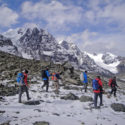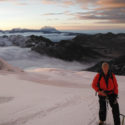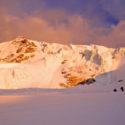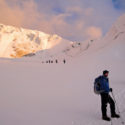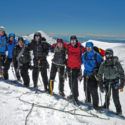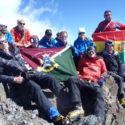In August 2012 a team of nine OCdts from East Midlands UOTC, led by OCdt Joe Holt ventured to Bolivia for Ex Illimani Sunrise, a demanding high-altitude expedition which aimed to develop the team’s alpine mountaineering skills, and climbed a series of peaks culminating with Nevado Illimani at 6350m the highest mountain in the Cordillera Real.
The team mustered at base in Nottingham where kit was issued and packed ready for our long but smooth flight to La Paz via Miami. We arrived early in the morning and moved in to Hotel Fuentes, our base point for the duration of our time in Bolivia. The effects of being at altitude were immediate and even the task of carrying kit up flights of stairs became difficult. This however was strategic; by spending our time prior to the mountain phases at 3,600m we were straight into acclimatising.
The day after we arrived we were met by our Bolivian Navy Liaison Officer Lt Marco Guttierez. He provided local assistance in Lima and for our visit to Lake Titicaca.
Our acclimatisation phase began with day walks in and around the ‘Moon Valley’ and Lake Titicaca – the highest navigable lake in the world. Here we were also welcomed by Lt Guttierez’s Bolivian Navy Unit who gave us a short presentation on their work patrolling the Peruvian-Bolivian border which bisects the lake and also accompanied us during our stay here, showing us the sights and educating us of the Incan history of the region.
Next we moved to the Condoriri Massif, our first foray into the impressive mountains which Bolivia is famous for. Here we met Captain Eric Guitierrez, the Bolivian Army’s senior mountaineering instructor who would be with us for the remainder of the expedition. Llamas were used to transport our kit to basecamp by Laguna Chiar Khota from where we could gaze up at the ‘Head of the Condor’ and it’s impressive ‘wings’. After a cracking meal by our chef Nemesio, we all got a good night’s rest. In the following days we climbed Pico Austria 5100m then conducted Alpine Mountain Proficiency (AMF) training covering glacial skills, use of axe & crampons, rope techniques, avalanche risk and snow pack analysis, roped travel and crevasse rescue. We were now ready to climb our first alpine ascent. Next a 2am torchlit start gave us plenty of time ascend the glacier to reach the summit of Pico Tarija (5,225m) which afforded us spectacular views of the Amazon basin to the East and out towards the Atlantic basin in the West. The Condoriri area training now complete, we headed back to La Paz to prepare for our next objective, Huayna Potosi.
After a rest/admin day in La Paz, we were back in the mountains at Laguna Zongo base camp (4,750m) to prepare for Huayna Potosi, our first taste of climbing above 6,000m. Bad weather kept us sheltering in the refuge for 24 hours which meant we had to make it to the summit in one push rather than the standard overnight at high camp. A 1am start, plenty of grit and determination and several hours of navigating through crevasse fields later, we were stood at the summit atop the exposed ridge and feeling on top of the world. The summit was an airy 6076m high. We then made a careful retreat in worsening weather all the way back down to the base camp at 4600m and returned to La Paz.
Back in La Paz, the team took a days break to face the challenge of cycling the Death Road. Fortunately, no-one met their end here though there were a few near misses! Now in La Paz, the main challenge of the expedition, Illimani at 6350m loomed over us – as it does for those who live in La Paz and we soon found ourselves heading up a dirt road into the remote villages at the base of Illimani, ready to tackle the challenge with the skills gained on our previous peaks. A gentle walk-in took us to the base camp at 4,500m, followed the day after by a long and at times precarious move via rock slabs up to the ‘Nest of the Condors’ high camp at 5,600m. We planned a 2am start, but a night storm caused us to delay our departure until 5am. Thankfully the storm abated and we were able to start our ascent. The route climbed along a narrow ridge to start with, then wove through crevasses up some fairly broad slopes to the summit ridge at about 600m. Here, the whaleback ridge rose to the right and we slowly made our way in the rarified air with the sun now well risen to the south summit, the highest of Illimani’s three peaks. It had been extremely hard work and was a moment for us all to savour as we reflected on our journey up to this point and the incredible views we were now rewarded with. The descent was tiring as we had to clear our high camp and make our way just as night fell to base camp.
Our final few days in Bolivia were spent on a R&R package which took in the sights of the Uyuni salt flats and the Amazonian rainforest where we spent two days exploring national parks, visiting bat caves and learning about the local culture before white-water rafting down the Esperito Santo River and heading back to La Paz to board our flight home.
On behalf of EMUOTC we would like to thank all those who supported us in this endeavour, financially the Ulysses Trust and AMA and those who through their vast amount of experience helped in planning this arduous expedition. We would also like to give special thanks to the Bolivian Army & Navy for the immense support and camaraderie they provided us; we hope we can return the favour sometime in the future. Also to our army instructor Maj Tolan whose huge experience and instruction enabled the team to obtain and develop vital mountaineering skills and learn just how far they could push themselves to overcome daunting obstacles. Further, excellent team cohesion has forged strong links within the unit which has laid the foundation for further challenging mountaineering expeditions to be led in South America for new recruits and to extend the adventurous spirit within EMUOTC.
Team on Tarija Summit 5250m. L-R OCdts Hole, Weezer, Holt, Baker, Piekarski, Byrd, Marsden, Andrews, Aynsley-Smyth, Capt Guttierez, Maj Tolan

